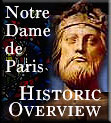

Structural Designs of Gothic Churches
and Cathedrals :
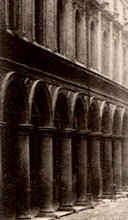 The Romans were the first to widely exploit arcades in such structures as the Coliseum
at Rome. Arcades were utilized to set apart the nave from the aisles within the earliest
basilicas; by the Gothic era, well employed and beautifully decorated, they are featured
throughout sacred structures from triforia to cloister enclosures.
The Romans were the first to widely exploit arcades in such structures as the Coliseum
at Rome. Arcades were utilized to set apart the nave from the aisles within the earliest
basilicas; by the Gothic era, well employed and beautifully decorated, they are featured
throughout sacred structures from triforia to cloister enclosures.Image at right: Arcade at Church of Saint Maggiore, Bologna, Italy.
Distinctive Highlight from the Archives :
 The term "archivolt" is, however, rarely used of these mediŠval moldings. In good design
the moldings of the archivolt are confined to the voussoirs, and define correctly the intrados
and extrados of the arch. Archivolts are sometimes used, with purely decorative intent,
even where the extrados of the arch is stepped. Archivolts may be merely painted, in interior
decoration; and they may be flat bands of marble or glazed tile, as in Assyrian buildings.
The term "archivolt" is, however, rarely used of these mediŠval moldings. In good design
the moldings of the archivolt are confined to the voussoirs, and define correctly the intrados
and extrados of the arch. Archivolts are sometimes used, with purely decorative intent,
even where the extrados of the arch is stepped. Archivolts may be merely painted, in interior
decoration; and they may be flat bands of marble or glazed tile, as in Assyrian buildings.—The New International Encyclopædia, 1922
 The raising of crossing towers, initially constructed with wood, demanded exceptional
craftsmanship as, less flammable, stone became the building material of preference.
The raising of crossing towers, initially constructed with wood, demanded exceptional
craftsmanship as, less flammable, stone became the building material of preference.Image at right: The South transept tower rising over the crossing of Canterbury cathedral, England. (Engraved by John le Keux [1783-1846] from an original work by the painter George Cattermole [1800-1868].)
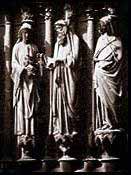
Image at right: Jamb Statuary within the West portal at Rheims cathedral, France.
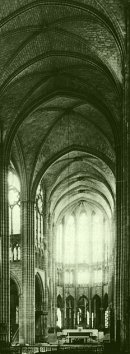
Image at right: The nave at St-Denis, Paris; showing the Quadripartite vault ceilings.
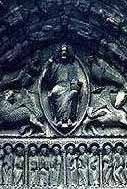
Image at right: Tympanum within the west portal of Notre Dame de Chartres, France.
“The mere detail of the Lancet style possesses the most exquisite loveliness of any style of architecture whatever. We might ransack all the edifices in the world, from the Treasury of Atreus to Henry VII's Chapel, and find nothing which can be for a moment compared to the perfect beauty of its detached marble shafts, with their deep cut bases, their bands, their capitals of the richest and most graceful foliage;
 of the wonderfully deep mouldings, forming the finest contrasts of light and shade; of the long rows of the most elegant and always satisfactory tooth-ornament; of the corbels, and bosses, and knots of foliage, the profusion of arcades, on which all this beauty is lavished. Succeeding styles carried out the Gothic principle more effectually, and formed a more perfect whole; but the Lancet style, as exemplified in its noblest production, the divine presbytery of Ely, must stand unrivalled for the grace and purity bestowed upon the minutest fragments of detail.”
of the wonderfully deep mouldings, forming the finest contrasts of light and shade; of the long rows of the most elegant and always satisfactory tooth-ornament; of the corbels, and bosses, and knots of foliage, the profusion of arcades, on which all this beauty is lavished. Succeeding styles carried out the Gothic principle more effectually, and formed a more perfect whole; but the Lancet style, as exemplified in its noblest production, the divine presbytery of Ely, must stand unrivalled for the grace and purity bestowed upon the minutest fragments of detail.”
“Remember how much this fine Egyptian work meant. It was not only that so many men were trained to do neat work: they must have had the mind behind the training that could demand it. The demands of each age were its ideals and were the really important things. You may have confidence in the interpretation of mind by the products of art. What, for instance, was there in the writings of the thirteenth century which gave such a perfect picture of the mediaeval mind as Salisbury Cathedral?”
—Prof. Flinders Petrie,Lecture, 1913
“The plan of the cathedral of Peterborough in England shows how a Romanesque church of large size was conceived. Such a church would have its aisles vaulted as soon as the bishop of the diocese could command a very small spare annual sum and the services of a tolerable master-mason. The clear-story of the choir and that of the nave would not be vaulted until the resources of the diocese were considerably greater. In the mean-time a wooden ceiling would be built above the clear-story, either flat and with bright-coloured painting for its only decoration, or carried along the lines of the rafters and collar beam in such a way as to seem crowned up in the middle, and to leave exposed a small part of the roof timbers. Such a roof, however, was frequently burned, or in other ways injured, and accordingly renewed in a new style.”
—Russell Sturgis,European Architecture -
A Historical Study, 1896

“At the first dawn of Gothic science, when the numerous and disastrous fires among sacred edifices led to the attempt to vault them with stone, a mixture of the Roman and Eastern methods seems first to have been tried, and some curious combinations of this kind are still to be seen in the old churches of Cologne and its neighbourhood. The superiority of the Roman system, however, soon led to its exclusive adoption, and it is to be seen in the naves at Durham and Ely, and the transepts at Ely and Winchester; but in extending this kind of ceiling to the central avenue, many difficulties arose, not perhaps so much from the increased span and height above the ground, as from the oblong form of the compartments; for the builders of this age very properly rejected the doubly-curved groins of Diocletian's baths, which indeed would have been quite impracticable over a plan differing considerably from a square. Various expedients were resorted to, and the only successful one for vaulting the clerestory with round arches alone, was by making its compartments square, and letting each correspond to two compartments of the side aisle.”
—Edward Lacy Garbett,Rudimentary Architecture, 1891
“Since the decline of Gothic architecture the ideas which have prevailed respecting it have been for the most part confused and incorrect. Indeed, until within the last fifty years only the most vague notions of it were entertained even by students of architecture. The very name Gothic, though not wholly inappropriate, originated in a spirit of contempt, which naturally precluded any disposition to study attentively enough to understand it, this splendid manifestation of human genius. The architects and amateurs of the schools of Sansovino and Palladio in Italy, where the revival of taste for classic forms of art had set in as early as the time of Brunelleschi, could not be expected to admire anything so far removed from the spirit of the art which was in fashion with them. The maniera Tedesca, as they called such Gothic as they possessed-supposing Gothic art to be of German origin, because their own pointed style was an importation from Germany-was regarded by them as barbaric and without principles, in comparison with their grammatical Vitruvian orders.”
—Charles Herbert Moore,Development and Character of Gothic Architecture, 1890
Bibliography
Matthew Holbeche Bloxam, London, D. Bogue (1846)
Eugène Viollet-le-Duc, Paris (1858-68)
Development & Production Credits
Primary Text : Rhey Cedron — Theme Editor : Nicole MarchStructural Design & Project Direction : Rhey Cedron
Art Direction : Thierry Alberto — Art Production : Mark Nelson & Ash' Murti
Principal Photography : Rhey Cedron
Art Research : Malcolm Hurrell — Support Research : Walter McCrae
(Life) Support Production : Henry Craig, Joan Flandrin, Clara Kelly and
a Patient Legion of Friends, Family & Angels
cultural projects. Ask to receive your free newsletter
Your questions or comments are always welcome!
Gothic Dreams E-mail
Individual use of enclosed material is encouraged for the purposes of education and enjoyment.
The republication of textual or graphic content, without license, is an infringement of Copyright laws.

